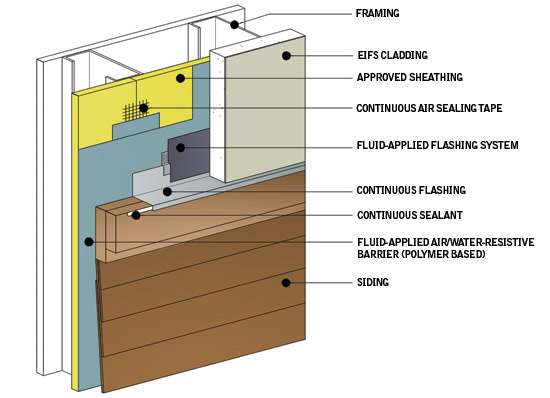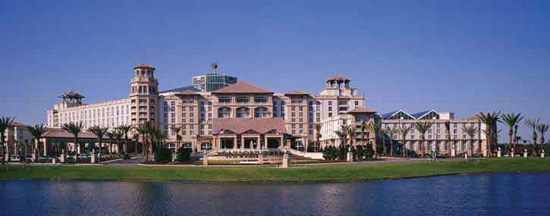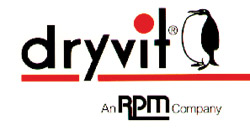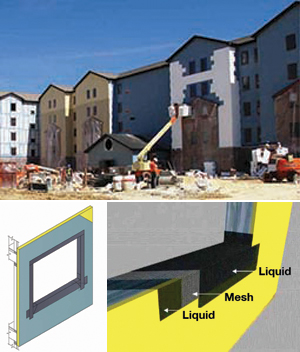Combination Air and Water-Resistive Barriers in Exterior Walls
Fluid-applied Membrane Materials
One of the increasingly popular product category choices for barrier materials in exterior wall construction is the use of fluid-applied membranes. This type of product has been used and proven for years particularly on below-grade walls with considerable success. It is essentially a spray, trowel, or roller applied compound that cures to a complete and continuous layer that can act as both an air barrier and water-resistive barrier (A/WRB). With growing interest in using this rather high-performance solution on walls of all sorts, different formulations have become available made from different core materials.
There are two general things to realize with this type of barrier system. First, the thickness of the application will vary based on the core materials used in its makeup. However, there is a common misperception that thicker applications will be better which is not necessarily so as we will see in further discussion. Second, these materials, like all other air and water-resistive barriers, are usually installed after the sheathing is in place but before final cladding, windows, or doors are installed, meaning that they remain exposed to the weather for some period of time. Fortunately, the makeup of most of the fluid-applied membranes is such that it will not break down or deteriorate when exposed to weather or sunlight as is sometimes the case with other A/WRBs. However there is always the need to protect the edges of any A/WRB installation. In sheet systems, blowing wind can cause edges to come loose or tear and allow debris to get behind the system. In fluid-applied systems, most of those concerns are eliminated, but the edges where the fluid application stops should be protected or covered to prevent any damage to the installation.
With the above in mind, we can look more closely at the two common types of fluid-applied membranes, namely asphalt based and polymer based.
Asphalt-Based Systems
Liquefied asphalt is the traditional material that has been used with or without some modifiers to achieve certain characteristics for water protection. The most notable characteristic about it is that it requires a thick application on the order of at least 60 – 80 mils to be effective as an A/WRB. It is common then for installers and building inspectors to measure the thickness in the field to assure that it qualifies as a code-compliant, effective barrier. This thicker application, in part, contributes to its “nail sealability”—the ability of the material to remain intact by sealing around a nail or other fastener that penetrates through the membrane to the wall construction. ASTM D1970 is the test used for testing the nail sealability, but it is really a test for roofing products, meaning that it is not directly replicating wall conditions. Nonetheless, it has become the accepted standard until something new can be developed.
There are some other characteristics about asphalt-based fluid-applied membranes worth noting. From a sustainability standpoint, they obviously rely on fossil fuels to create the oil-based asphalt. Their impact is not just at the product creation stage of their life cycle, but also at the end of life stage when the materials it is adhered to need be disposed of in a manner appropriate to other petroleum-based products. From a wall assembly standpoint, they need to be fully covered and protected as part of an overall assembly and tested in order to pass the NFPA 285 fire test. Further, asphalt may or may not be compatible with certain cladding or wall covering systems, particularly an exterior insulation and finish system (EIFS). Similarly, it is not compatible with un-faced rigid plastic insulation that may be used to meet thermal requirements for continuous insulation.
Polymer-Based Systems
In response to the limitations of other air and water-resistive barriers, fluid-applied systems that are polymer based instead of asphalt based have become readily available. Despite the obvious difference in material makeup, the most noticeable difference in its application is its much thinner coating that produces excellent results. Instead of the 60-80 mils sought in asphalt applications, polymer-based systems produce the same or better performance in only 9 -12 mils with a wet film thickness of approximately 20 mils. While this may seem like a small difference, in fact it is an 80 percent reduction or better of material. Multiplying that difference all across the wall surface of a building can amount to significant time, labor, and cost savings since it can go on quicker and more economically overall.
The makeup of the polymer produces a number of desirable characteristics to achieve a truly continuous, high-quality barrier system in exterior walls. Specifically, polymer-based systems, similar to some asphalt-based systems, have been tested and approved as both an air barrier and a water-resistive barrier, meaning that both functions can be performed with a single application. However, in response to varying needs and unlike asphalt products, they can be formulated to be either vapor permeable or non-permeable as a wall assembly system may require. Applied wet and allowed to dry, they create a truly continuous A/WRB without any seams or joints plus the ability to seal around all penetrations. Since there is no asphalt, they are fully compatible with virtually all cladding systems including EIFS—although each EIFS manufacturer has their own proprietary product. As part of a full wall assembly, they can meet all code requirements including the fire test requirements of NFPA 285.

Image courtesy of Dryvit Systems, Inc.
When a polymer-based fluid-applied membrane is incorporated and tested as part of an overall wall assembly, it can meet all pertinent code requirements for wall integrity, energy efficiency, and fire.
From an installation standpoint, polymer-based systems also have a number of advantages. As a water-based system, they are safer for workers to use and much more environmentally friendly. Since it is a single A/WRB product, it can be installed over the entire wall surface by one trade. In the event of difficult or challenging installations, polymer-based systems have been found to be more forgiving of surface conditions such as substrate moisture compared to asphalt-based materials. All of this contributes to the ability for manufacturers to offer a fully warranted system if approved installers are used.
Specifying Polymer-based Air and Water Barriers
Based on all of the above, here are a few things to take into account when specifying polymer-based A/WRBs. First, the ABAA makes a case for specifying them in a distinct specification section. Often they are included as part of another section related to wall finish or construction which may or may not be appropriate if the air or water-resistive barrier is installed by a separate trade. Fluid-applied membrane air barriers are listed as a separate section in the Master Format in Division 7 Thermal and Moisture Protection under section 07 27 26. If they are part of an EIFS system, the AWRB should be specified in the same section as EIFS to ensure compatibility as well as maintaining warranties for the owner. If a non-adhered cladding is used, the AWRB can be specified separately from the cladding.
The General, Part 1 portion of the specification should cite all of the code referenced standards discussed in this article for air barrier products and assemblies. Further, ABAA certification can be requested on both the material and the wall system as may be available. Where required due to building height, evidence that the assembly meets NFPA 285 fire testing should also be indicated. When it comes to project conditions for storing materials in terms of environmental factors such as temperature, humidity, etc., then manufacturers' information should be cited since individual products vary. Warranties are available and can be specified, but will also vary between manufacturers.
The Products or Part 2 portion of the specification will generally be very straightforward. The fluid-applied membrane material itself should be specified as a flexible, polymer-based, non-cementitious, combination water-resistive membrane and air barrier. Some manufacturers offer choices of textured or smooth finish and a spray option. The appropriate selection should be made accordingly primarily based on the substrate material and the cladding covering. Any accessory materials related to flashing or interfacing with windows, doors, etc. should also be specified here and be supplied by the same manufacturer to assure that a complete, continuous system is achieved.

Photo courtesy of Dryvit Systems, Inc.
Properly designing exterior wall systems and specifying appropriate barrier systems will help keep air and water outside while contributing to the long and beneficial use of the building.
The Execution or Part 3 portion of the specification section should not be underestimated since this is where the performance is either assured or compromised. An experienced, qualified subcontractor should be performing the work and should begin with a thorough examination of the walls. The sheathing/substrate should be fully complete and ready to receive the fluid-applied membrane. All building flashing that is to drain off of the A/WRB should be in place and all openings, penetrations, and special conditions should be appropriately prepared and ready for treatment. The nature of the thinner polymer-based coatings may be unfamiliar to some building inspectors or whole building commissioning agents. In those cases, it may be appropriate to consider a mock up or test area to establish a standard of acceptance for the project. Since mil gage testing will be based on a thinner coating than asphalt-based products, it may be appropriate to consider using manufacturer coverage rates to establish an acceptable performance basis. Once these things are reviewed and agreed upon, then full application and coverage can be performed on the entire building. Once complete, the finished A/WRB should not be left exposed to the weather for more than 30 days primarily to protect the interface areas with other materials, flashings, and openings.
Conclusion
The benefits of polymer-based, fluid-applied air and water-resistant barriers have been realized in thousands of projects. Understanding how they differ from other fluid-applied barrier materials, particularly in terms of thickness and complete, continuous sealing ability, allows for ready code compliance and assurance that they are meeting the appropriate standards. Overall they help provide better exterior wall design and performance over the life cycle of the building.
 |
Outsulation® by Dryvit is a fully tested, code-compliant EIFS, providing an air/water-resistive barrier, exterior CI, and durable finishes to buildings worldwide. Outsulation offers lower construction costs, improved energy efficiency, and long-term sustainability compared to other exterior walls. The final appearance can look like brick, stucco, metal, granite, and limestone. www.dryvit.com |









